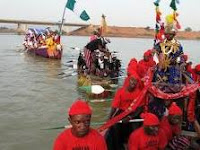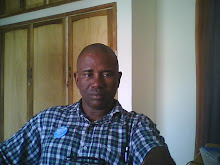Friday, February 10, 2012
Friday, September 3, 2010
Monday, December 14, 2009
AFRICAN MASK.
Masks are produced in order to enable the souls of the dead or the protective spirits of a village or society to make their appearance in tangible or visible manner or for a dramatic representation of mythical actions.
Masks are made in a variety of forms: To cover the face only.
Enclose the head like a helmet or,
Be placed as a head dress on the head.
There are however masks that are not worn but are venerated as sacred objects or miniatures serving as a form of badge or crest of secret societies. Very much like the ancestral figures, masks are also imbued with power and consecrated. They are sacred and to dissacred them would bring mortal consequences.
The moment a masquerade cult initiate wears and conceals himself in the costume of the mask, it is assumed he is no longer a normal human with limited powers. He is now imbued with supernatural powers.
The masquerade comes forth with solemn gait at times on a stilt, and speaks in a sinister manner, generally conveying an awesomeness one can only attribute to a spirit, amidst the throbbing of drums, singing, dancing, and oviations by spectators; as the masquerade makes its spectacular appearance.
There is a whole hierachy of masquerades in African societies, Starting from the highest; great spirit masks, which appear on very rare occassions or decisive moments in the life of the tribe, village etc, to those that settle disputes, collect debts, enforce law and order, nocturnal masks that expel the soul of the dead, or witches, to masks that entertain people.

 Masks/maquerades have very important sociological, political, pyschological roles as well as reducing tension from time to time; In places where there is no central government, they are very important means of social control, while reinforcing the sense of group identity through initiation into masquerade, and ansestral cults.
Masks/maquerades have very important sociological, political, pyschological roles as well as reducing tension from time to time; In places where there is no central government, they are very important means of social control, while reinforcing the sense of group identity through initiation into masquerade, and ansestral cults. Wednesday, December 9, 2009
ANCESTRAL FIGURE / FETISH OBJECT In African Art.
An ancestral figure is a wood sculpture, a dignified and solemn symbol of a tribal hero, the first mother of a tribe, the ultimate dwelling place of the tribal soul, imbued with power. It provides a link between the gods and men.
Ancestral figures exhibits all special features and characteristics of the tribe; tribal marks, coiffures, emblems etc.
They are made in such a way that they please the spirit being invited to make its dwelling in the figure. The figure is done in the semblance of a handsome young virgin male or a beautiful virgin girl who's spirit is drawn into the figure on complettion and consecration; Through earnest prayers, sacrifices offered in the form of blood of animals and in very extreme cases human blood, pouring libations, first fruit of the harvest to mention a few.
The figure imbued with power, takes part in the life of the tribe, community or family. Mediates protection, fertility, riches, blessing of children, makes its will known through signs or its priests.
The large sculptures are usually the communal possesion of a tribe, village, clan, large family or society. They are usually kept and cared for by a priest, and brought out and worshipped during festivals and ceremonies.
The small figures, may be owned by individual, as personal gods - they are placed in secluded corners in the house and reverenced periodically.
FETISH OBJECTS.
The fetish object is an object imbued with magical substances, usually of indeterminate form, made and consecrated by a medicine man It protects the person who calls upon it, in every imagineable situation and from all dangers. Some fetish objects may be found with the features of the sacred tribal ancestors or powerful, and dynamic leader or ancestor; all these are what we count as art works nowadays.
Friday, December 4, 2009
AFRICAN ART 2
 African Art consists mainly of traditional sculptures of wood, clay craft, terra-cotta, stone, bronze, wrought iron, masks, used for social, economic and religious life of the people. It also exhibits indegineous music, dance, masqurades and traditional folklores.
African Art consists mainly of traditional sculptures of wood, clay craft, terra-cotta, stone, bronze, wrought iron, masks, used for social, economic and religious life of the people. It also exhibits indegineous music, dance, masqurades and traditional folklores.Africans create their art primarily as an avenue through which they make contact with the supernatural. It is an expression of their religion. Not art for art sake. They believe that the supernatural force is something tangible; For this reason, they create sculptures which serve as a medium of giving them access to the supernatural/spirit world. The ancestral figures, fetish items, masks and other cult objects are all poducts of this desire to commune with the Spirit world. Wood is the best-known medium used in African sculptures;especially in creating ancestral figures,masks and some fetish items and cult objects.
Wood sculptures are carved with similar implements throughout the continent. An axe which is usually used to fell the tree after the wood carver must have performed purifying sacrifices to appease the gods and the spirit that is believed to reside in the tree.
The adze a tool with its's cutting edge at rigth angle to it's hahdle, is used to do greater part of forming the sculpture. The speed and skill achieved with the adze will baffle a foreign observer. Intricate and delicate forms are created with different shapes and sizes of knives.
The works are finished by sanding with rough barks/leaves, stones, charring, staining with earth colours, soot, leaves, before oiling. In modern times enamel paints are used, other modern tools such as chisels, wood rasp, sand papers etc are now used.
Tuesday, December 1, 2009
African Art 1
Chinua Achebe, in his book MORNING YET ON CREATION DAY (New York: Anchor Press? Double Day, 1975), P.29. stated that "Art is, and was always, in the service of man. Our ancestors created their myths and legends and told their stories for human purposes; they made their sculptures in Wood and Terra-cotta, Stone and Bronze to serve the needs of their times! Their artists lived and had their being in society and created their works for the good of the society".
By virtue of our thoughts and imagination, great works of Art have always been produced. Under the control of artists, images are reflections of the society and the the artists opinion and thoughts
In the not too distant past, folklore and traditional African Art have been intergrated into every day life, functioning as indicators for social, political, religious and economic beliefs and concerns, interweaving the philosopical and spiritual frame work of tradition and culture.
African Art has exhibited a continuity which has survived till date, though conditions are varying in present day Africa;- materials, theme/subject matter , patronage etc- the works of African artists reflect the past. they belong to the same artistic continuum in African Art which treat forms as symbols or aggregation
symbols and relate forms to metaphysics.
African Art is interwoven with every day life in ways very different from Western Art. Religious beliefs and cultural ideals find artistic expression not only in ancestral figures, fetish objects, ritual/worship objects and masks, which are created primarily for ceremonial or ritual purposes; but also as practical/personal objects for day to day existence.
These Art objects gives the people a sense of order to the diversity and complexity of day to day life. There's no where else in that the interplay between Art and personal objects is more prevalent than in African society - which may be responsible for the fact that Art is taken for granted in African societies.
By virtue of our thoughts and imagination, great works of Art have always been produced. Under the control of artists, images are reflections of the society and the the artists opinion and thoughts
In the not too distant past, folklore and traditional African Art have been intergrated into every day life, functioning as indicators for social, political, religious and economic beliefs and concerns, interweaving the philosopical and spiritual frame work of tradition and culture.
African Art has exhibited a continuity which has survived till date, though conditions are varying in present day Africa;- materials, theme/subject matter , patronage etc- the works of African artists reflect the past. they belong to the same artistic continuum in African Art which treat forms as symbols or aggregation
symbols and relate forms to metaphysics.
African Art is interwoven with every day life in ways very different from Western Art. Religious beliefs and cultural ideals find artistic expression not only in ancestral figures, fetish objects, ritual/worship objects and masks, which are created primarily for ceremonial or ritual purposes; but also as practical/personal objects for day to day existence.
These Art objects gives the people a sense of order to the diversity and complexity of day to day life. There's no where else in that the interplay between Art and personal objects is more prevalent than in African society - which may be responsible for the fact that Art is taken for granted in African societies.
Thursday, November 26, 2009
Nsibidi was a means of communication around Cross River, Ekoi, Igbo, and Ibibio areas South-East Nigeria and the Camerouns.
Nsibidi was a mysterious and closely guarded secret script used by the rich powerful and influential men in Ekpe secret society in these areas.
It was employed in the form of pictograms and symbols. Nsibidi is akin to the heiroglyphics of ancient Egypt or Chinese ideograph. Nsibidi was in three forms, the first were not really secret or mystical they were common signs representing human affairs, relationships and communication. The second were more or less representing danger, extremities- they were dark signs. The third type were the very important signs and symbols of rank and rituals which were closely guarded secrets known only to initiates and their priests
Nsibidi scripts is seen on tomb stones of members, walls of Ekpe society buildings, carved on calabashes, drawn on ritual objects, costumes and textiles, on the ground, tattooed on the body. Today, Nsibidi is known as Anaforuana and still practiced by Abakua secret society members among black Cubans. These are descendant of Nigerians and Camerounian slaves who went there with the secret.
The development of this means of expression and decoration was hampered by colonialism and western religion. It has been the desire of many modern artist especially those of Nsukka Art School (who have work extensivly to dicpher Uli body decoration among the Igbos) to unearth the riches of this ancient human endeavour. Tony Nwachukwu, and late Okpu Eze.A before him and many others have worked hard at studying this indegenous means of writing.
Their works of art are made after the Nsibidi tradition. The trained eyes will read proverbs, folklore out of the works, while the untrained eyes will be thrilled by the intricate use of lines colours and forms.
The paintings:1) untitled batik work, 2) an untitled acrylic work by Tony Nwachukwu using Nsibidi scripts (call 2348035528317)
Subscribe to:
Comments (Atom)
















